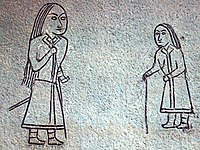古突厥
此條目需要擴充。 (2017年10月18日) |
| 突厥 | |
|---|---|
 刻有古突厥人的岩畫(6至8世紀) | |
| 分佈地區 | |
| 中亞 | |
| 語言 | |
| 古代突厥語 | |
| 宗教信仰 | |
| 薩滿教 |
古突厥(古漢語:鐵勒;中古藏語:Drugu[1];突厥字母:𐱅𐰇𐰼𐰰:𐰜𐰇𐰛(Kök Türk);維吾爾語:كۆك تۈرك (Kök Türk);土耳其語:Gök Türk;英語:Celestial Turks、Blue Turks或Kok Turks;塞語:Ttūrka、Ttrūka[1];)是大約漢代至唐代在內亞的一個游牧部族,使用古代突厥語,在匈奴部族統治下,歷經與周圍鮮卑族、東胡、柔然、漢族、以至於西亞地區一些游牧民族等通婚和繁衍,形成了一眾分散的古突厥語部族。漢代(約公元前2世紀到公元2世紀)曾隸屬於匈奴,晉朝時則隸屬於鮮卑之下。隨着中國進入五胡十六國時代,塞外游牧民族接受漢化、紛紛南下到中國北方建立政權,塞外草原出現了游牧政權的真空,於是在土門的領導下,這一支突厥語部族發展成了突厥汗國,並因此得名。
除了建立突厥汗國的這支鐵勒部族,同時期其他的鐵勒部族在突厥汗國建立後仍稱鐵勒或敕勒,一部分在突厥汗國崩潰並西遷後形成了回紇民族。在西方以至於歐洲一帶,尚有欽察、保加爾人、巴爾卡爾人等,也被認為來源於古突厥人。
詞源
[編輯]古突厥語為 𐱅𐰇𐰼𐰰 Türk,[2][3] 或𐱅𐰇𐰼𐰰:𐰜𐰇𐰛(Kök Türk)(突厥語意為「藍突厥」或「天突厥」)[2][3]。古漢語最初在漢代時(大約公元1-2世紀)以「鐵勒」、「敕勒」稱呼,「突厥」之名始見於《周書》卷二七《宇文測傳》。在西方文籍中始見於東羅馬人阿伽提亞斯(?-582)著作,作Kök Türk。現代西方文獻中的Göktürk是 古突厥語Kök Türk的現代土耳其語形式。
'''Türk'''一詞在 古突厥語和諸現代突厥語中意為「強大」或「力氣」[4]。在《周書·異域傳》中則將該詞解釋為:突厥「居金山(即阿爾泰山)之陽……金山形似兜鍪,其俗謂兜鍪為「突厥」,遂因以為號焉。」
族源
[編輯]突厥的起源並未有定論,大致可以確定的是,他們可能帶有匈奴的血統。 《北史》記載「突厥者,其先居西海之右,獨為部落,蓋匈奴之別種也。另一說出自平涼雜胡。又曰突厥之先,出於索國,在匈奴之北。」
古突厥人政權
[編輯]- 突厥汗國:古突厥人於公元552年建立的古代國家,全盛時期的疆域包括今蒙古高原全部、中亞北部,統治範圍東起大興安嶺,西至裏海,北越貝加爾湖,南抵阿姆河南岸。583年分裂成東突厥和西突厥。
- 東突厥:突厥汗國分裂後,東部的承繼政權,屬於藍突厥。公元630年,被薛延陀部與大唐國(桃花石)所滅。
- 西突厥:突厥汗國分裂後,西部的承繼政權,公元657年,被大唐國所滅。
- 後突厥汗國:東突厥汗國與西突厥汗國分別滅亡後,古突厥人於682年在蒙古高原重建的政權。突厥最早的文字記載即始於這一時期。公元745年被回鶻汗國取代。
統治者
[編輯]古突厥人遺傳
[編輯]2018 年 5 月發表在 自然雜誌上的一項基因研究檢查了四名古突厥精銳士兵的遺體,這些士兵被埋在大約 公元 300 年和公元 700 年。[5]提取的Y染色體樣本屬於單倍群Q-M242(樣本 DA86),[6] 單倍群R1(樣本 DA89,[6] DA224)和單倍群O-M175 (樣本 DA228 [7])。[8]提取的線粒體DNA樣本屬於單倍群C_(線粒體DNA) C4b1(樣本DA86)、單倍群A_(線粒體DNA) A14(樣本DA89)、單倍群H_(線粒體DNA) H2a(樣本DA224)和單倍群A_(線粒體DNA) A15c(樣本DA228)。[9]被檢查的古突厥人被發現比之前的天山匈人有更多的東亞人種血統。還發現了歐洲血統的證據,表明與歐洲的持續接觸。隨後的中亞突厥國家顯示出更高水平的東亞血統,這表明中亞的突厥化是由東亞人種血統的主要少數民族進行的。[10][11]
參見
[編輯]參考資料
[編輯]- ^ 1.0 1.1 Golden 2011,第20頁.
- ^ 2.0 2.1 Kultegin's Memorial Complex, Türik Bitig (頁面存檔備份,存於網際網路檔案館) 闕特勤碑
- ^ 3.0 3.1 Bilge Kagan's Memorial Complex, Türik Bitig. [2017-04-28]. (原始內容存檔於2014-10-06).
- ^ American Heritage Dictionary. The American Heritage Dictionary of the English Language: Fourth Edition - "Turk". bartleby.com. 2000 [2006-12-07]. (原始內容存檔於2013-06-22).
- ^ Damgaard et al. 2018,Supplementary Table 2, Rows 60, 62, 127, 130.
- ^ 6.0 6.1 Haplotree Information Project - Ancient DNA. haplotree.info. [2021-03-08]. (原始內容存檔於2021-08-03). Map based on public dataset on www.haplogroup.info by Carlos Quiles (www.indo-european.eu).
- ^ Haplotree.info - Ancient DNA. Map based on All Ancient DNA v. 2.06.03.. haplotree.info. [2021-03-08]. (原始內容存檔於2021-07-25).
- ^ Damgaard et al. 2018,Supplementary Table 9, Rows 44, 87, 88.
- ^ Damgaard et al. 2018,Supplementary Table 8, Rows 128, 130, 70, 73.
- ^ Damgaard et al. 2018,第4–5頁. "We find evidence that elite soldiers associated with the Turkic Khaganate are genetically closer to East Asians... These results suggest that Turkic cultural customs were imposed by an East Asian minority elite onto central steppe nomad populations... The wide distribution of the Turkic languages from Northwest China, Mongolia and Siberia in the east to Turkey and Bulgaria in the west implies large-scale migrations out of the homeland in Mongolia... [T]he genomic history of the Eurasian steppes is the story of a gradual transition from Bronze Age pastoralists of West Eurasian ancestry towards mounted warriors of increased East Asian ancestry..."
- ^ Damgaard et al. 2018,Supplementary Information, p. 12.
參考書目
[編輯]- Christian, David. A history of Russia, Central Asia and Mongolia, Vol. 1: Inner Eurasia from prehistory to the Mongol Empire. Blackwell, 1998.
- Findley, Carter Vaughn. The Turks in World History. Oxford University Press. 2004 [2017-04-28]. ISBN 978-0-19-988425-4. (原始內容存檔於2020-08-03).
- Golden, Peter Benjamin. Ethnogenesis in the tribal zone: The Shaping of the Turks. Studies on the peoples and cultures of the Eurasian steppes. Bucureşti: Ed. Acad. Române. 2011 [2017-04-28]. ISBN 978-973-1871-96-7. (原始內容存檔於2019-03-21).
- 蘇聯大百科全書, 3rd ed. Article "Turkic Khaganate" (online(頁面存檔備份,存於網際網路檔案館)).
- 雷納·格魯塞. The Empire of the Steppes. Rutgers University Press, 1970. ISBN 0-8135-1304-9.
- Gumilev, Lev (2007) (俄文) The Göktürks (Древние тюрки ;Drevnie ti︠u︡rki). Moscow: AST, 2007. ISBN 5-17-024793-1.
- Skaff, Jonathan Karem. Nicola Di Cosmo , 編. Military Culture in Imperial China. Harvard University Press. 2009. ISBN 978-0-674-03109-8.
- Yu. Zuev (I︠U︡. A. Zuev) (2002) (俄文), "Early Türks: Essays on history and ideology" (Rannie ti︠u︡rki: ocherki istorii i ideologii (頁面存檔備份,存於網際網路檔案館)), 阿拉木圖, Daik-Press, p. 233, ISBN 9985-4-4152-9
- Wechsler, Howard J. T'ai-Tsung (Reign 626-49): The Consolidator. Denis Twitchett; John Fairbank (編). The Cambridge History of China, Volume 3: Sui and T'ang China Part I. Cambridge University Press. 1979. ISBN 978-0-521-21446-9.
- Wink, André. Al-Hind: The Making of the Indo-Islamic World. Brill Academic Publishers, 2002. ISBN 0-391-04173-8.
- Zhu, Xueyuan (朱學淵) (2004) (中文) The Origins of the Ethnic Groups of Northern China (中國北方諸族的源流). Beijing: Zhonghua Shuju (中華書局) ISBN 7-101-03336-9
- Xue, Zongzheng (薛宗正) (1992) (中文) A History of the Turks (突厥史). Beijing: Chinese Social Sciences Press (中國社會科學出版社) ISBN 7-5004-0432-8
- Nechaeva, Ekaterina. The "Runaway" Avars and Late Antique Diplomacy. Ralph W. Mathisen, Danuta Shanzer (編). Romans, Barbarians, and the Transformation of the Roman World: Cultural Interaction and the Creation of Identity in Late Antiquity. Ashgate. 2011: 175–181. ISBN 9780754668145.
- Sinor, Denis. The Cambridge History of Early Inner Asia. Cambridge University Press. 1990 [2017-04-28]. ISBN 978-0-521-24304-9. (原始內容存檔於2020-08-30).
延伸閱讀
[編輯][在維基數據編輯]
